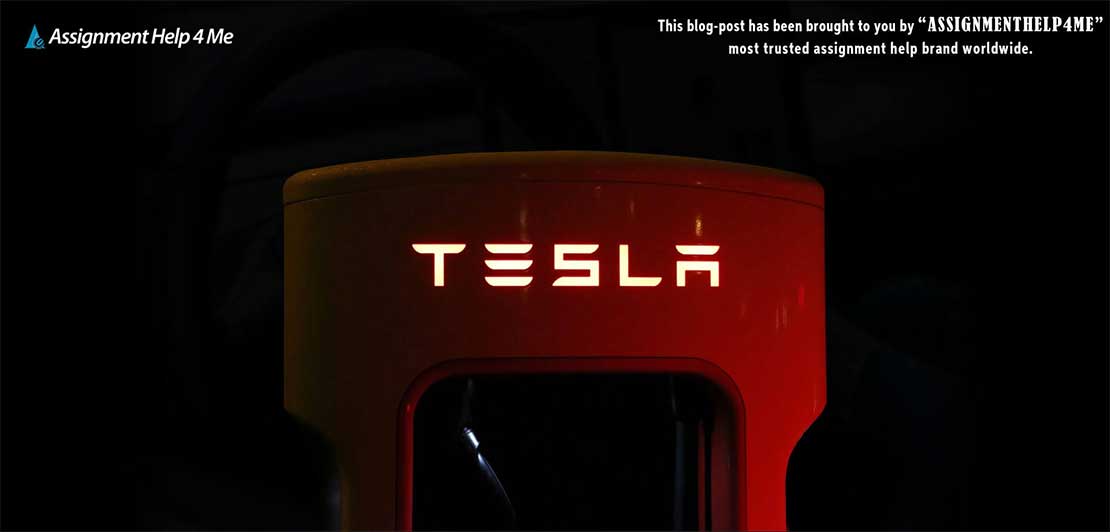

Contents
An intelligible and comprehensive strategic analysis of Tesla
Isabelle Taylor | 28 Aug,2021
Introduction
The main purpose of this report is to evaluate the growth of the electric vehicles industry at the pace of globalization and to determine the strategies implemented by Tesla to maintain its competitive position in the market. In this strategic analysis, you will get to know about the external market factors that are supporting or threatening the growth of the electric vehicles industry. The competitor analysis of Tesla is also performed in this report and the major strategies adopted by Tesla to effectively compete in the market are also identified in this strategic analysis report. Besides this, the internal analysis of Tesla is also performed in this report through the use of various internal analytical tools i.e. VRIO, SWOT, business canvas model, etc. At the end of this report, recommendations for Tesla are provided on the basis of the strengths and the core competencies of the company.
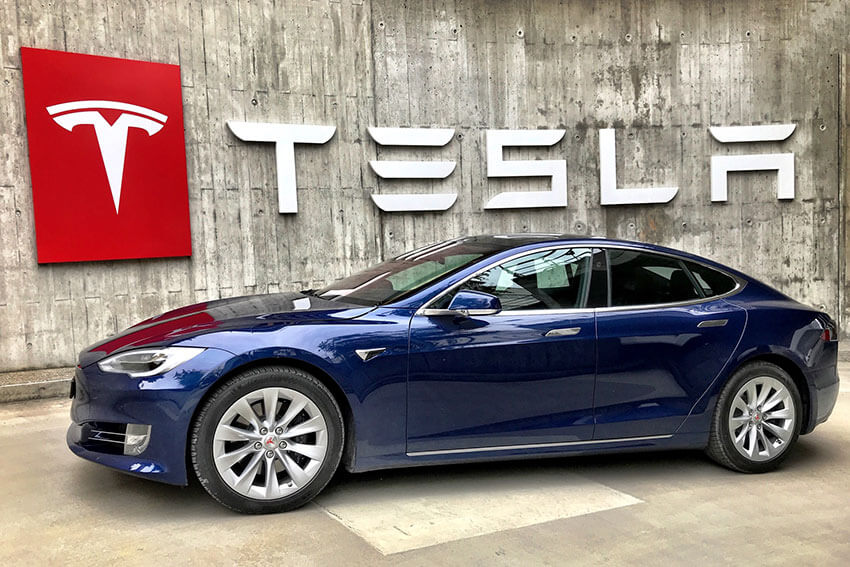
History of Tesla
Tesla is an American electric vehicle company that was founded in 2003 as an electric car company. This company was founded by two engineers i.e. Martin Eberhard and Marc Tarpenning in 2003 and the headquarter of this company is located in Palo Alto, California. Furthermore, in February 2006, the company also led the Tesla series B with the investment of $ 13 million. Further, the production of roadster was started in 2008 and in 2009, the company raised USD 187 million and then delivered more than 147 cars. However, in 2012, the company also ceased the production of roadster cars and then launched its second car i.e. Model S luxury Sedan. Further, the driver assistance system was also launched by the company in 2014 and in 2015, the company entered the energy storage market by launching powerwall and powerpack industrial battery packs. The third vehicle i.e. SUV model X was launched by the company in 2015 and by the end of 2015, the company was selling around 10000 vehicles per quarter. Further, the fourth vehicle model of the company i.e. Model 3 sedan, was launched in 2017 which emerged as a more affordable alternative as compared to the previous models. Consequently, the company procured around 455000 reservations for model 3 by the end of August 2017. Not just this, Tesla also created its own Gigafactory outside the United states in 2019 and the construction of the new Gigafactory projects is also underway in Berlin, Texas and Germany. In addition to this, in 2020, the company also began delivery of the fifth vehicle model i.e. Model Y crossover. Along with this, the global vehicle sales of Tesla were 499,550 units in 2020 with production of around 1 million electric cars.
Mission and vision of Tesla
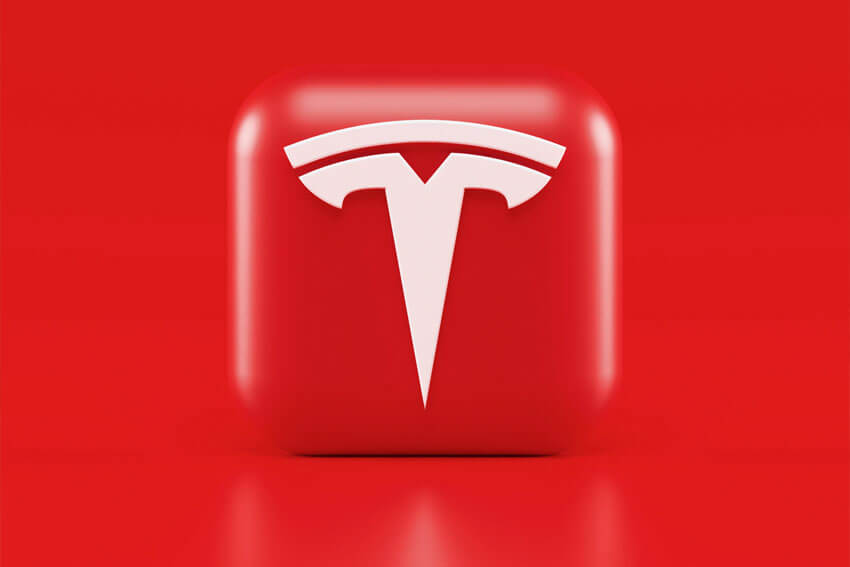
Tesla is the leading electric vehicle company that manufactures vehicles that use electricity and gas for running. The mission of Tesla is to accelerate the advent of sustainable transportation by establishing a mass market for electric cars. Further, the vision of Tesla is to be recognized as the most compelling car company of the 21st century.
Electric car industry analysis - Tesla industry analysis
The electric car industry has attained significant importance in the current times due to the increasing demand for low emission commuting, zero emission vehicles and higher concern for sustainability. Further, around 2.1 million electric cars were sold in 2019 which was only 9 % higher than the number in 2018 and the reason for the same was the decline in the sales of electric cars in the second half of COVID-19 in two largest markets i.e. China and the US (Virta, 2021). Further, the sales of electric vehicles in 2019 at international level is shown as follows-

The above figure shows that the overall demand for electric vehicles is rising in the current times and it was only because of the outbreak of COVID-19 which negatively impacted the sales of electric cars in 2020.
Several countries have taken long strides towards a cleaner future and the rise in the electric vehicle market is one of the major initiatives in this direction. China leads the electric car market and according to the China Association of Automobile Manufacturers, there were sales of 1 million battery electric vehicles and 0.25 million sales of plug-in hybrid vehicles in 2020. Further, the average sales of China for electric vehicles is over 2,904 electric cars per day. Several European markets also have seen triple-digit growth in the EV industry. Besides this, Norway also has the highest share of electric cars to the total passenger car sales in the country. The United States is the third-largest market for the EV industry but the US market grew only by 4 % between 2019 and 2020. The following horizontal bar graph shows the growth rate of the EV industry in different markets-
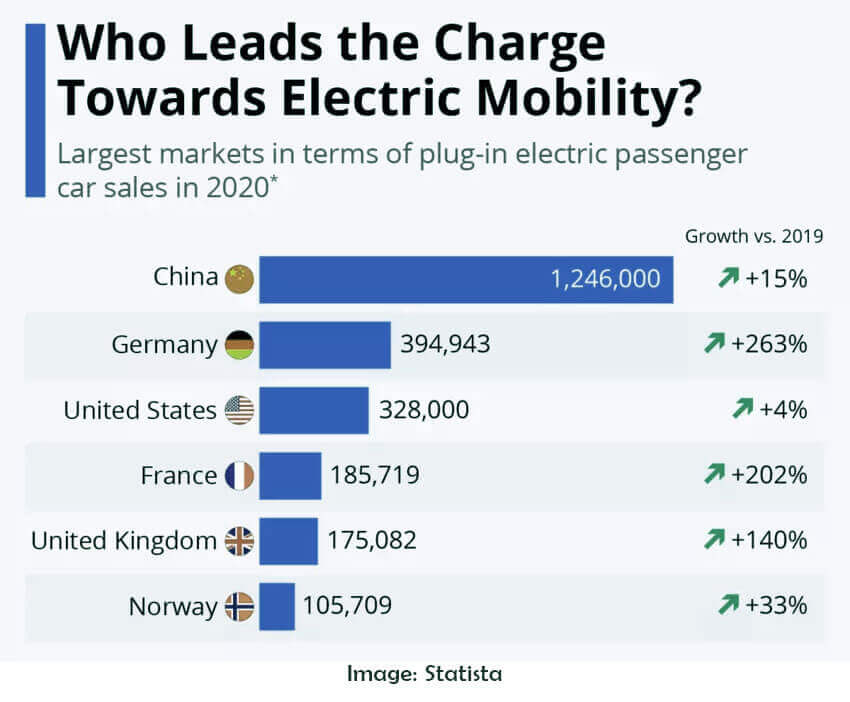
Norway is one of the greenest countries that sells around 80000 EVs per year which is equivalent to 148 EVs per 10,000 people (Garg, 2021). Further, the following table shows the comparison of the countries in terms of density of EVs per 10,000 people-
| Country | EVs sold per 10,000 people |
|---|---|
| Norway | 148 |
| Sweden | 41 |
| Netherlands | 40 |
| Canada | 15 |
| Germany | 13 |
| UK | 11 |
| US | 10 |
| France | 9 |
| China | 7 |
| Korea | 5 |
The above table shows that Norway is at top of the list of the number of EVs sold per 10,000 people followed by Sweden. However, China has only 7 EVs per 10,000 people but the speed of manufacturing of Electric cars in China supports that the day is not so far when the Density of EVs in China will exceed the number of EVs in the UK, US, and France. Further, the demand for EVs in India is still very low and major demand for EVs in India is for electric commercial vehicles and two-wheelers.
China leads the EV car industry in terms of the units of production and the US lags behind China and Germany in terms of the number of units of production which is shown as follows-

Thus, it is seen that China is the largest EV producer all over the world and China is expected to produce around 13 million battery electric vehicles by the end of 2023. Despite this, (Kolodny, 2021) also identified that the US automakers represent 18 % of total EVs being produced between 2010 and 2020 with 85 % of the output being produced by Tesla. Further, 25 % of global electric vehicles between the same period were manufactured in Europe. Along with this, India is also expected to become the leading manufacturing hub for Electric vehicles in the coming times as the Union government of India is currently focusing on various alternative technologies such as hydrogen fuel cell-driven EVs to boost manufacturing of EVs for export purposes. The declining prices of lithium-ion batteries are also expected to influence the demand for EVs in the country. The Indian Prime Minister, Narendra Modi has also stressed on the need to increase local production of EVs to increase the number of zero-emission vehicles on roads and to reduce the dependence on the import of crude oil (Ghosh, 2021). In addition to this, it is also announced by the Union Minister of Road Transport and Highways that Karnataka will also be home to the Tesla factory. Further, various government policies such as Faster Adoption and Manufacturing of (Hybrid &) Electric Vehicles is also supporting the growth of the EV industry in India. FAME in India provides subsidies for EV production and charging infrastructure for growth in the use of EV vehicles (K.J., 2021).
It is not just that the automakers are embracing electric vehicles but buyers also are willing to pay a premium price to buy the electric vehicles. This is because the buyers always wanted to buy inexpensive, easy to maintain, and environmentally sustainable vehicles. Electric vehicles are less expensive and also do not contain an internal combustion engine which provides a smoother driving experience. The use of electric vehicles is also more environmentally friendly as they do not contribute to pollution or carbon footprint. Further, the demand for other EV vehicles such as e-rickshaws, e-two wheelers, etc. is expected to rise in the near future. Hence, companies like Tesla can focus on expanding their product portfolio to further improve their market image and demand for products.
Tesla core values
The main focus of Tesla is on delivering high quality services to customers and the core values of the company include respecting people, always doing the best by applying the best available technologies, forecasting, respecting the environment and promoting learning oriented work culture (TESLA, 2021).
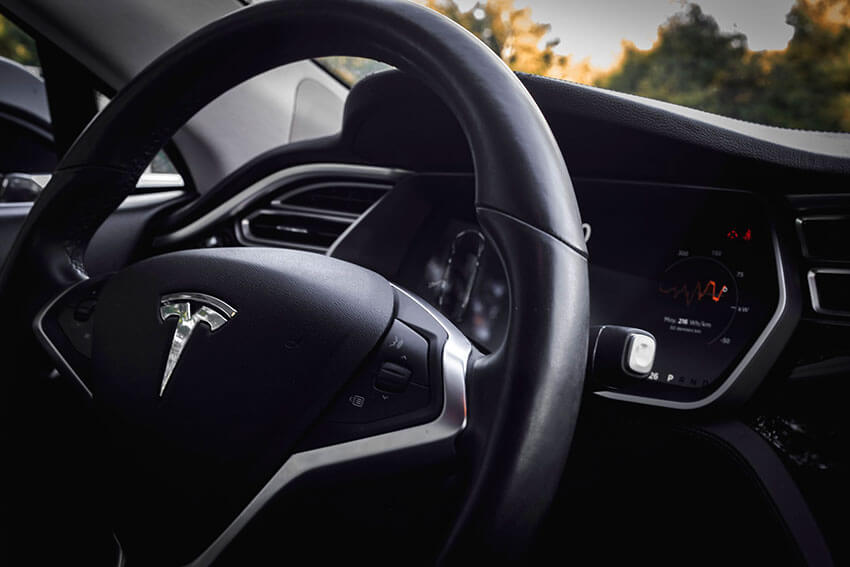
Tesla external analysis
The external environment is favorable for the growth of Tesla as despite impacts of COVID-19, the electric car industry is still found to be growing at a very fast rate and the total registration for Electric vehicles in different countries is shown as follows-

Thus, the demand for electric vehicles is rising at a very fast pace due to increasing concern for sustainability and low emission vehicles. Further, the declining battery cost is another major advantage for the growth of Tesla and Tesla pays only $ 142 per kWh for the battery cells as compared to $169 per kWh for GM (LeBeau, 2021). Tesla also sold more than 88000 electric vehicles in the first quarter of 2020 despite the impacts of the covid-19.
Tesla PESTEL analysis
Tesla is a multinational company and the globalized business firms are impacted by various external market factors. The PESTEL analysis is an important external market analysis tool that can be used by business organizations to review and evaluate various external market factors. The PESTEL analysis of Tesla is performed as follows-
Political factors affecting Tesla
The political environment is highly favorable for the growth of the electric car industry due to higher government support in form of subsidies, Tax rebates, and effective electric car incentives. Also, the government across the world spent $ 14 billion in 2020 to support the sales of electric cars. The clean vehicle rebate project in California also offers electric car incentives of value up to $ 7000 on new EVs. Further, the Clean fuel reward program in California also offers incentives worth up to $ 1500 when buying and leasing electric vehicles. Along with this, California was the first state to propose a zero-emission sales requirement for heavy-duty trucks. Along with this, the Clean Car Discount scheme implemented by the New Zealand government also aims to make electric and low emission cars cheaper for New Zealanders. The US president also has announced $ 7.5 billion for facilitating EV charging infrastructure. However, the US still lacks an effective supportive approach for EV as compared to China and Europe. Further, the zero-emission light-duty vehicle policies in different countries are shown as follows-
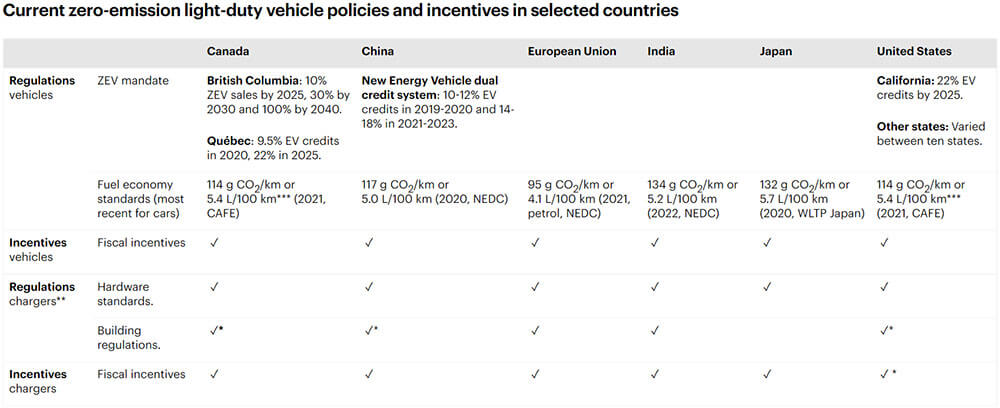
The above figure shows that China, EU, and India maintain specific minimum standards but Canada, Japan, and the US do not have specific standards. The UK government also offers a discount of $ 3840 on the new EV vehicles under $ 48670 (Fleming, 2021). Further, the vaccine power initiatives are likely to improve the growth of the economy at the global level. However, various political factors such as Brexit, the US-China war, etc. are impacting the growth of electric car operators. For instance, due to diverse impacts associated with Brexit, Tesla chose Germany rather than the UK to establish a new plant. Not just this, the US-China war has negatively impacted the growth of the EV industry. Tesla and other foreign automakers are required to pay a tariff of 25 % to sell the cars in China (Rosenbaum, 2018).
Economic factors affecting Tesla
The outbreak of covid-19 presents huge challenges to the global economy and the sales of EV vehicles in China and the US dropped by 57 % and 33 % in the first quarter of 2020 respectively due to a sharp decline in the customer demand. Hence, the COVID-19 is expected to leave a negative impact on the sales and profitability of the EV industry. Also, the global GDP is also expected to be 3.2 % lower than the pre-pandemic forecasts due to a decline in income and employment rate in the covid-19 period. However, the global economy is still expected to expand by 5.6 % in 2021 which is likely to have a positive influence on demand for electric vehicles in the post-covid period. The rise in fuel prices is one of the major positive factors for the growth of the EV industry as increasing fuel prices is causing a surge in the demand for green vehicles in the country. Further, during the last quarter of 2021, the demand for electric vehicles in New Delhi, India increased by 30 % due to a hike in petrol prices (New Indian Express, 2021). In addition, the oil prices also have a positive impact on the sales of electric vehicles as customers also have started to buy more fuel-efficient cars and other vehicles after the rise in prices of oil (Reuters, 2021).
Social factors affecting Tesla
The demand for electric vehicles is rising in the current times due to increasing concern for environmental sustainability. The demand for EV vehicles is highest among Generation X followed by Millennials as the younger generations are becoming more aware of the sustainable and economic benefits of owning electric cars (Butler, 2021). Besides this, the modern and healthy lifestyle is another main factor that is influencing the growth of the electric car industry as the speed, convenience, sustainability, comfort, style, and status associated with the use of EV attracts various customers. Moreover, the demand for electric cars is rising among green communities as the use of electric vehicles also eliminates the consumption of fuels. The use of electric cars is also cheaper when compared with the traditional petrol-based cars as the cost of maintenance is very low for electric cars. In addition, the cost of electric car batteries is shrinking in the current times which further has resulted in a decline in the prices and higher demand for electric cars. EV vehicles are also cheaper and easy to register. For instance, the Queensland Government offers discounts on stamp duty and other discounts on registration while purchasing EV.
Technological factors affecting Tesla
In addition to subsidies and tax benefits associated with EV purchase, the government authorities are also investing in technological innovation such as charging infrastructure to promote the growth of electric cars. In addition, there is increasing growth of wireless EV charging which helps to automatically charge the vehicles in the parking locations. In addition to this, new battery technologies such as Lithium-ion-batteries and graphene-based technologies are coming up which will help to ensure fast charging of the vehicles. Further, technological innovation in the near future will help the company to come up with fully driverless Technology which will help the company to achieve a technological competitive advantage in the industry (Driivz, 2021).
Environmental factors affecting Tesla
Global warming is a major concern area for every nation which further has resulted in an increased need for environmental sustainable measures. The rising concern for environmental consciousness is one of the main factors which is influencing the growth of Tesla in the market. The Tesla cars are environmentally friendly and do not cause GHG emissions. Also, Tesla cars help to reduce fuel consumption which further helps in reducing pollution and carbon emissions. Not only this, but the company also had installed over 3.5 gigawatts of solar cells by the end of February 2019 which helps in producing 13 terawatts of clean and emission-free electricity (Tesla, 2018). Moreover, Tesla also has produced the largest Lithium battery in the remote area of South Australia in 2017 which further can store up to 129 megawatts of energy from the wind turbines (Toscano, 2019).
Legal factors affecting Tesla
Since the company operates at a global level, Tesla is required to comply with various laws and regulations in the international market. As a result of this, the company has developed various laws and policies which include Tesla UK modern slavery act, tesla worldwide and anti-corruption policy, salvaged vehicle policy, etc. (Tesla, 2021). However, Tesla is facing the issue of the crash of a Tesla Model 3 into a police car which may impact the reputation of the company by causing huge litigation against the company.
Porter five forces analysis of Tesla
The porter five forces is an important competitive analysis tool that can be used to evaluate the competitive position of the company. The following table shows the porter five force analysis of Tesla:
| Porter five forces analysis of Tesla | Detail |
|---|---|
| Bargaining power of suppliers of Tesla | The bargaining power of the suppliers of Tesla is moderate as Tesla is heavily dependent on its suppliers for the production of various vehicles. Also, Tesla’s supply chain processes are vertically integrated and the major supplier of the company is Panasonic. Further, the increase in production of goods over the period of time will help to reduce the bargaining power of the suppliers as the company will be able to attract a large number of suppliers for large orders. |
| Bargaining power of buyers of Tesla | The bargaining power of the customers in the EV vehicle industry is very low and Tesla has established a huge customer base in the industry which further reduced the bargaining power of customers. Also, Tesla provides premium connectivity options such as satellite view maps, traffic visualization, video streaming, internet browsing, etc. to customers for different vehicles such as Model S and X which helps to reduce customer bargaining power. |
| Threat of substitutes to Tesla | The threat of substitution in the automotive industry is high as the customers have diverse options available to them. Further, public transportation is one of the important substitutes available to personal cars which further increases the threat of substitutes. Also, the cost to switch to another EV car manufacturing company is very low. |
| Rivalry among the existing competitors of Tesla | The competitive rivalry among the existing firms in the EV market is moderate as Tesla has achieved a leading position in the market and also enjoys the first-mover advantage in the industry. However, various other firms such as Volkswagen, BMW, etc. are coming up with new designs and car models which increase the competitive threat for Tesla. Despite all this, Tesla is leading Electric car company which is shown as follows- 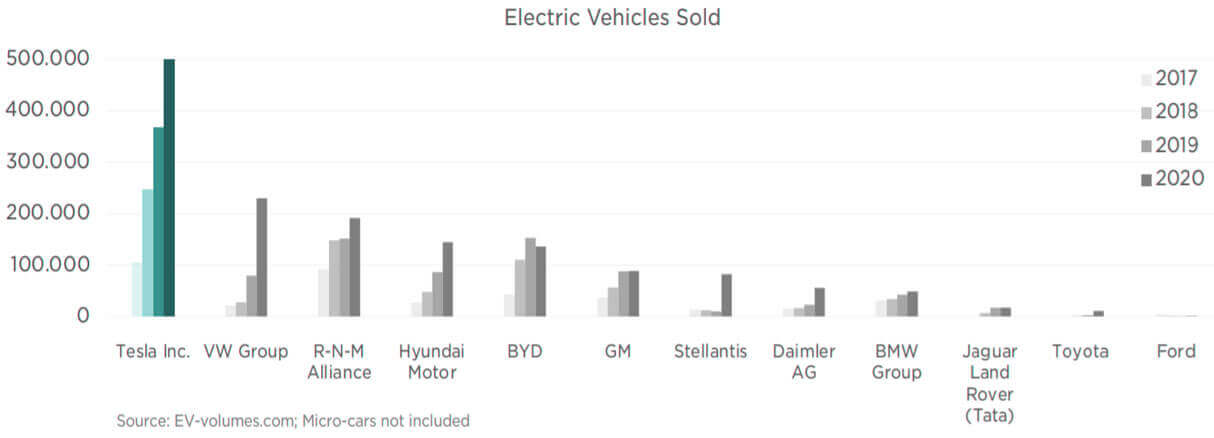 Thus, it is found that Tesla beats all the other competitors in the market due to a number of factors which include a strong supply chain network, effective management processes, technological advancement, a higher focus on environmental sustainability, extensive research and development, etc. Thus, it is found that Tesla beats all the other competitors in the market due to a number of factors which include a strong supply chain network, effective management processes, technological advancement, a higher focus on environmental sustainability, extensive research and development, etc. |
| Threat of new entrants to Tesla | The threat of new entrants is low as higher barriers to entry, higher competition, and huge investment needed in this industry reduce the chance of entry of new firms in the industry. Further, a huge cost is required to be incurred on research and development before entering this industry which also reduces the threat of entry of new firms. Not only this, the economies of scale being achieved by the leading organizations such as Tesla also reduces the threat of new entrants. |
Tesla competitor analysis
Tesla is well-positioned as a high-end luxury car company that has captured significant market share in the industry due to its high performance, advanced technologies, established brand image, and unique competitive position. Tesla Model S is one of the most accepted car models that have several advantages over the other car models such as the BMW i3. The Tesla Model S has a longer range and thus is very beneficial for the people who travel a lot. Also, Model S is easy to drive and more efficient as compared to BMW. However, the key disadvantage of the Model S of the company is that the Model S of Tesla takes hours to fully charge but the Toyota Mira uses hydrogen as the source of energy storage and can be refilled in only 3 minutes. Despite this, Tesla model S is cost-efficient and the Chevrolet Bolt is overpriced. Tesla Motors has achieved a dominating position in the US market which is shown as follows-

The above figure shows that Tesla maintained a market share of 81.66 % in the EV industry of the US and out of a total of 87398 vehicles being sold, Tesla sold around 71,375 vehicles in the US EV market. Further, Tesla S has achieved a market share of 29 % followed by a market share of 16 % of Tesla Model X. In addition to this, the market capitalization and Earning per share of different competitors in the automobile industry is evaluated as follows-
| Firms in the automotive industry | Market capitalization | EPS |
|---|---|---|
| Tesla | 706.30 | $ 0.64 |
| Toyota | 9284 | $ 13.42 |
| BMW | 76.80 | $ 6.55 |
| General motors | 48.18 | $ 4.33 |
| Ford Motors | 12.73 | $ 0.01 |
Thus, it is found that the market capitalization and EPS of Toyota is highest in the EV industry followed by the market capitalization of Tesla and EPS of BMW.
Tesla competing strategy
The main competing strategy that is adopted by Tesla in the market is broad differentiation and market penetration. The main sources of competitive advantage to Tesla include full self-driving models, effective supply chain practices, vertical integration, and gigafactories. Tesla targets premium as well as low price buyers in the automobile industry through its wide range of product offerings.
Tesla Competitors
Tesla is intensively growing by generating revenue from development, sales, and automotive services. Also, the automotive companies face tough competition from each other, especially in the EV market. Tesla’s continued growth strategy and innovation have helped the company in improving the market share and increasing sales. The main competitors for Tesla include Ford Motor Company, GM (General Motors), Volkswagen, Honda, Hyundai, etc. However, the main competitor of Tesla is Volkswagen due to its continued expansion by acquiring different brands such as Audi, Bentley, Porsche, etc. (JACKSON, 2021). This further is likely to decrease the sales gap that exists between both the companies. During the fiscal year 2020, the revenue of Tesla increased by approximately 28 percent (Carlier, 2021). Over the years, Tesla has been successful in building a competitive advantage through the distribution of batteries that are generally of better quality as compared to competitors. Further, the Tesla vehicles are more energy efficient which further helps the company to achieve a strong market image and reputation. The following figure shows the EPA range of various electric car models-

This shows that the Tesla cars have the highest energy efficiency of all the electric vehicles. Further, the Tesla Model 3 standard range has achieved the EPA of 5.1 miles/ kWh. Also, the Model Y achieved the EPA range of 4.2 EPA miles / kWh which further makes it the most energy-efficient SUV. Hence, it is found that Tesla car models have gained importance not only because of a higher brand image but also due to a higher focus on environmental sustainability.
Tesla positioning analysis
The positioning map of Tesla and its competitors has been prepared on the basis of quality and price for the products supplied to the consumers. It could be analyzed that Tesla supplies high-quality products in the market through the premium pricing strategy. Also, the map includes several other competitors of Tesla such as BMW, Volkswagen, and NIO, etc. that are also known for supplying high-quality products at high prices in the market. The positioning map of Tesla is shown as follows-

The above positioning map of Tesla shows that Tesla has been positioned as the premium electric car company that manufactures and sells high-quality electric vehicles to the customers through its technological innovation and strong research and development practices.
Tesla internal analysis
The internal analysis of Tesla involves analysis of the internal factors of the company. The internal analysis also involves a method of evaluating the company’s assets, resources, strengths, and weaknesses. The internal analysis of Tesla is performed as follows-
VRIO analysis of Tesla
VRIO analysis is an analytical technique that helps to evaluate the core competencies of the organizations and factors that provide a competitive advantage to the organization. The VRIO analysis of the company is shown as follows-
| Valuable | Rare | Inimitable | Organized | Competitive advantage | |
|---|---|---|---|---|---|
| Brand image | Yes | Yes | Yes | Yes | Long term competitive advantage |
| Product portfolio | yes | yes | yes | yes | Long term competitive advantage |
| Differentiation | yes | yes | yes | yes | Long term competitive advantage |
| Leadership | yes | yes | yes | yes | Long term competitive advantage |
| Production capacity (Gigafactory) | yes | yes | yes | No | Unused competitive advantage |
| Supply chain | yes | yes | No | No | Temporary competitive advantage |
| Human resources | yes | yes | No | No | Temporary competitive advantage |
| Intellectual property | yes | yes | No | No | Temporary competitive advantage |
| Solar energy systems | yes | yes | yes | yes | Long term competitive advantage |
| Internal work environment | yes | yes | No | No | Temporary competitive advantage |
| Technological innovation | yes | yes | Yes | No | Unused competitive advantage |
Tesla non-core competencies and competitive disadvantage
The main sources of competitive disadvantage for Tesla include poor internal working environment, ineffective supply chain management due to production challenges, and poor human resource management practices. Tesla is also accused of labor violations in the past and in 2015, the rate of injuries among workers at Tesla was 8.8 injuries per 100 employees (Hinchliffe, 2017). Tesla continues to face supply chain disruptions and several production issues due to which the production of the company is negatively affected. Tesla faced a global chip shortage and port disruptions that have caused a decrease in the productivity of the company. Further, the regulatory hurdles faced by the major factories such as Gigafactory poses the major problem of lack of batteries. Due to this, additional expenses had to be incurred by the company that had a negative impact on the operations and financial conditions of the company (ROSS, 2021). Tesla cars generally have high maintenance costs which are regarded as a competitive disadvantage for the company.
Tesla Core Competencies
On analyzing the core competencies of Tesla, it can be said that, due to its wide product portfolio and strong brand image in the market, the company is successful in gaining long – term gaining competitive advantage. Product differentiation has also helped the company in gaining a huge market share and become a leader in the sales of electric cars. In addition to this, Tesla has established in–house capabilities particularly in the test engineering and design of electric vehicles along with their components. Tesla is known for offering computer-aided designs along with durability and strength that have helped in the reduction of time taken for the development of the new product (Tesla, 2021). Another core competency for the business is expansion while finding the ways that actually help in localizing the design of their products.
Tesla Core Resources & Capabilities
The core resources and capabilities of Tesla are a strong team that is focused on designing innovative products, advanced technological upgrades, unique product design that offers competitive advantage and differentiation to the consumers, etc. These resources have also helped the company in attracting a huge customer base. In addition to this, the primary production facilities of the company also help Tesla to achieve a strong competitive position in the market. The following table shows the primary manufacturing facilities of Tesla-

Hence, it is found that Tesla has established its production facilities in different locations to facilitate an easy and direct supply of electric cars to customers. Besides this, strong revenue streams also provide a strong competitive position to Tesla, and the major revenue streams of Tesla are shown in the figure as follows-

Thus, it is found that Tesla earns revenue from different channels which include energy generation, automotive sales, leasing, and other services. Furthermore, the total revenue of the company is also rising at a faster pace due to the increasing brand image and recognition of Tesla.
SWOT analysis of Tesla
SWOT analysis is a strategic planning technique that helps to evaluate the strengths, weaknesses, opportunities, and threats. The SWOT analysis of the company is shown as follows-
| Strengths of Tesla | Weaknesses of Tesla |
|---|---|
|
|
| Opportunities to Tesla | Threats to Tesla |
|
|
Tesla business strategy analysis
Tesla has adopted the market penetration strategy as the intensive growth strategy of the company is mainly focused on increasing the sales of the company in the current markets. The mission of the company is to accelerate the world’s transition through sustainable energy. In addition to this, under the intensive growth strategy, the company grows by developing new products through the use of advanced technologies. Thus, the intensive growth strategy of Tesla is also focused on product differentiation. Tesla also launched the Tesla Roadster which is one of the quickest and high-performance electric luxury cars in the world. The use of product differentiation strategies helps the company to achieve a strong competitive position in the market. Further, the other major strategy adopted by the company under the intensive growth strategy is extensive research and development as intensive research and development help the company to launch differentiated products and generate higher sales.
Market development is also adopted by Tesla as the tertiary intensive growth strategy where the company focuses on entering the new markets worldwide to expand the market reach and to generate more sales. This intensive growth strategy of Tesla also supports the mission and vision of Tesla “to drive world transition to electric vehicles”.
Strategic alliances of Tesla with other firms also help to ensure market expansion and a strong competitive position in the market (Cheong et al., 2016). Tesla started to sell its all-electric Roadster model in 2008 but the company faced various technical and cost-related issues in the market in the initial years. However, all these challenges were also mitigated effectively by turning prospective rivals into alliance partners. Tesla entered into a strategic alliance with Daimler in 2009 which provided Tesla with superior engineering expertise and cash infusion. In addition to this, the strategic alliance of Tesla with Toyota also enabled Tesla to buy the NUMMI factory in California. Not just this, the strategic alliance of Tesla with Osaka also enabled both the companies to invest $ 5 billion in a Lithium-ion battery plant in Nevada (Hoang & Rothaermel, 2016).
Tesla business model
Tesla has adopted a direct-to-customer (D2C) business model where the company sells its products directly to the customers by eliminating all the middlemen such as dealers from its supply chain network. Also, the supply chain practices of Tesla are vertically integrated as the company runs and operates its plants where the electric vehicles are manufactured. The Tesla manufacturing plants and Gigafactory also supply the products to the company through the direct distribution channels which include the company physical and the online store which then sells the products and services to the customers. Tesla also has created its supercharger stations where Tesla cars can be charged in only 30 minutes free of cost. The main purpose behind the supercharger stations is to speed up the growth of electric cars.
Tesla business model canvas
Tesla has achieved a strong market position through broad differentiation and effective marketing strategies. The business model canvas of Tesla is shown as follows-
| Key partners | Key activities | Value propositions | Customer relationships | Customer segments |
|---|---|---|---|---|
| OEM alliances Panasonic for battery development Charging point partners such as resorts, shopping centers, etc. Leasing companies Toyota (manufacturing and purchasing) Government Daimler Suppliers (windshield, brake manufacturers, etc.) | Manufacturing Sales Design Research and development Software development | Autonomous driving Solar energy systems 14000 superchargers Fully electric cars Energy-efficient systems High performance Modern design | Customization Supercharge network Direct to the customer sales model Creating higher customer gains through the launch of new cars The Tesla Model S is voted as the most loved car in the US. | Luxury car buyers Sports cars buyers Commercial vehicles Mid-price range Green community Tesla followers Fast sports cars enthusiast |
| Key resources | Channels | |||
| Brand image | Tesla website | |||
| Big data | Tesla physical stores | |||
| Autonomous driving | Media | |||
| Gigafactories | ||||
| Battery technology | ||||
| Cost structure | Revenue streams | |||
| Manufacturing cost | Car sales | |||
| Distribution cost | Maintenance | |||
| Human resource expenditure | Upgrades | |||
| Infrastructure | Leasing operations | |||
| Administration expenditure | Solar energy panels | |||
| Research and development | Battery technologies | |||
| Selling cost | ||||
Tesla marketing analysis
The marketing analysis of Tesla includes qualitative and quantitative assessment of the market through analysis of the product portfolio, marketing strategies, customer segments, and pricing decisions of the company. The marketing analysis of Tesla is performed as follows-
4Ps analysis of Tesla
The marketing mix of Tesla Inc. stands out in the automotive industry and this provides a competitive edge to the company. Further, Tesla Inc. continues to use its marketing mix strategies to ensure market penetration and business expansion. The marketing mix of the company is discussed as follows:
Product verticals of Tesla
Tesla is known for manufacturing electric vehicles and the three major car models of the company include model S, model X and model 3. Further, each of the three car models is made with a powerful engine that can run with the speed of 60 mph in only 3 seconds. Before launching the three car models, the company had launched its sports car with the name roadster. Moreover, Tesla is also bringing change in its product base by adding batteries, solar panels, EV components, etc. Along with this, the company also has started production of model Y in its Shanghai factory. In addition, Tesla also manufactures different energy solutions such as Powerwall, Powerpack, Solar roof, etc. to provide homeowners and businesses to manage the energy generation and storage functions. Not only this, Tesla also manufactures the batteries at a large scale to effectively meet its production goals (Tesla, 2021).
Pricing strategy of Tesla
Tesla Inc. has adopted a premium pricing strategy due to huge costs being associated with research and development. However, the prices being charged by Tesla are still lower than the prices of BMW. For instance, the starting price of the Model S of Tesla is $79,990 and the Model X of Tesla starts from $89,990 (Koses, 2021). In contrast to this, the price of the BMW i8 is USD 144395.
The main mission of the company is to accelerate the growth of electric vehicles to ensure higher sustainability. However, high pricing policies will create problems in achieving its Vision and Mission. Thus, the company is also coming up with affordable car models such as model 3 to ensure the easy availability of EVs among customers. Along with this, model 3 of the company starts at the price of $35000. Moreover, the standard range of model Y of Tesla will start at USD 41990 and the long-range will start at USD 49990. Thus, the company is currently shifting from premium pricing strategies to value-based pricing strategies to achieve its vision of becoming the major car company in the 21st century and driving a double transition to EV's.
Place / distribution channels of Tesla
Tesla is a US-based company that has its headquarter in California and distribution networks at the international level. One of the important markets for the company in China and the company also has established its Gigafactory in China in 2019. The distribution network of this company also includes stores in Asian markets, Europe, Dubai, South Korea, Australia, and North America. Along with this, the company has adopted a direct-to-consumer sales approach where the EV is sold by Tesla directly through its stores and service centers. Also, the company offers inspection and other services at its service stations. Not only this, but the company is also establishing new Giga factories in Berlin, Germany, and Texas.
Promotion strategies of Tesla
Tesla also has adopted unique promotion strategies to establish a strong competitive position in the industry. Tesla has implemented the use of media release and public relations strategy with the aim to create a positive brand image and higher brand awareness (Manecuta, 2021). In addition to this, Tesla also has adopted effective social media marketing strategies to take advantage of social media marketing strategies. Further, the Promotional strategy of the company also includes the name of Tesla mentioned on its surcharging stations established at highways and malls.

Social media marketing analysis of Tesla
The social media platform and other online channels of Tesla also help to create mass awareness. Tesla also has uploaded around 150 videos on its YouTube channel and the number of followers of the company on Facebook is more than 2.6 million. Also, the official website of Tesla plays an important role in raising customer awareness and sharing specific information about specific models of cars. Moving further, the positive word of mouth, referrals, etc. are other important promotional strategies of Tesla which helps to attract a large group of customers towards its car models. Not just this, the social media presence of Tesla is booming in the current times as Tesla strives to develop a strong competitive position against various larger brands. Also, Tesla uses multiple tweets to attract and engage a number of followers in its post. In addition to this, Tesla has around 8,626,206 followers on its Instagram page with around 672 uploads. However, the customer engagement rate of Tesla on Instagram is only 3.82 % which depicts the lack of influencer marketing strategies of the company. The Public relations department of Tesla has always been small and thus, the company is currently focusing on improving its social media marketing strategies to improve customer engagement across its brand. The company has 6.3 million on its Twitter page and Elon Musk has achieved 39 million followers. The Elon Musk profile also helps to ensure higher engagement of followers on the Tesla page (Christophe, 2021). Tesla also has the highest number of followers on Twitter of any electric car company. Along with this, Tesla also posts creative and innovative content on its social media sites which helps to promote authentic connections with various customers.
STP analysis of Tesla
STP is a three-step marketing framework that helps the organization to segment the market, target customers, and position the company in the market. The STP analysis of Tesla is performed as follows-
Segmentation of Tesla
| Segmentation | Segmentation criteria | Customer segments |
|---|---|---|
| Geographic | Region | Asia, Europe, and North America |
| Density | Urban and rural | |
| Demographic | Age | 25 to 65 years |
| Gender | Both male and females | |
| Occupation | Employees, senior managers, executives, and professionals | |
| Income level | High income group people | |
| Psychographic | Life style | Environment conscious, green community, aspirer, explorer, succeeder, and reformer |
| Social class | Upper-middle-class people | |
| Behaviour | Benefits | Environment-friendly vehicles, cost-efficient, modern, and sustainable |
| Personality | Determined, environment conscious, and ambitious | |
| User status | Non-users, potential users, first-time users, and regular users |
Targeting- Target market of Tesla
Tesla mainly targets the high-income group and environment-conscious people for its environmentally friendly and premium car models. Furthermore, the Tesla products are considered as expensive for the average customer due to the premium price being charged for various car models. However, the Tesla Model 3 targets middle-class customers due to the low price being charged. Along with this, the Model S and X of Tesla are focused on the family as these models are equipped with 7 seats.
Positioning strategy of Tesla
Tesla has been positioned as an environment-friendly car company due to a range of electric and hybrid car models. The following table shows the fuel efficiency, fuel cost, and vehicle type of different electric vehicles
| Car models | Fuel efficiency | Annual fuel cost | Type |
|---|---|---|---|
| Chevrolet Malibu Hybrid | 46 mpg | $ 900 | Midsize hybrid sedan |
| Ford Focus Electric | 107 MPGe | $ 600 | Compact electric car |
| Tesla Model X 75D | 93 MPGe | $700 | Electric midsize SUV (Young, 2021) |
| Honda Accord Hybrid | 47 mpg | $ 900 | Large hybrid sedan |
| Tesla Model 3 Long Range | 130 MPGe | $500 | Electric midsize sedan |
| Tesla Model S 75D | 103 MPGe | $650 | Full-Size electric sedan |
Thus, it is found that Tesla is one of the eco-friendliest car companies and the Tesla Model 3 can run with the fuel efficiency of 130 MPGe with an annual fuel cost of only $ 500.
Consumer analysis of Tesla
The demand for the Tesla cars is mainly driven by the two main factors which include rising prices of fossil fuels and increasing desire for environment-friendly vehicles among customers. In America, around 200,691 of the cars were registered by Americans only which was 16 % higher than the Tesla car registration in 2019. The following table shows the total registration of different car models in 2020-
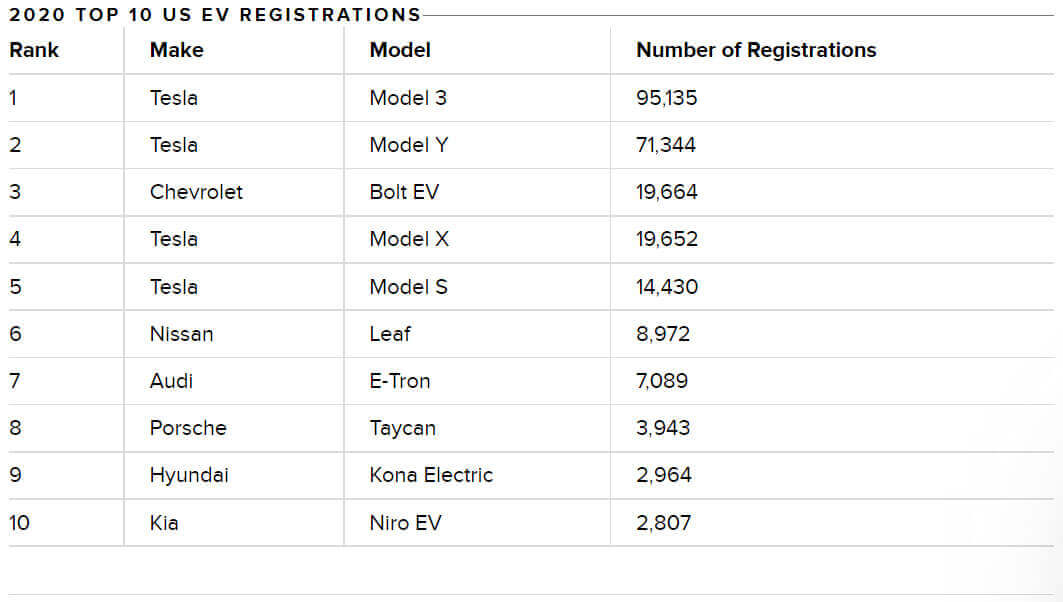
Thus, it is found that the demand for Tesla is highest in the market and the company mainly targets eco-friendly consumers who purchase pure electric or hybrid electric vehicles (Economic Times, 2021). The demand for eco-friendly vehicles is also influenced by the compelling desire of the green communities to reduce GHG emissions. Tesla targets both males and females for its electric cars but the customer profile of Tesla mainly includes the male customers looking for premium luxurious and sports cars. The target customers of Tesla include tech-savvy, environment-conscious, and green-friendly customers. The demand for Tesla cars is not only rising among environmentally conscious customers but also among the tech-savvy individuals due to technological advancement and status associated with the ownership of Tesla cars. (VOELCKER, 2021) also argued that non-owners of Tesla showed greater concern to purchase Tesla due to full self-driving technology, autopilot suite of advanced driver assistance systems, etc.
Recommendations for Tesla
The analysis of the current market position of Tesla helped to determine that Tesla has achieved a strong brand image in the market due to effective supply chain operations, strong technological innovation, and a higher focus on environmental sustainability. However, it has been found that there still exist various areas of non-core competencies which lead to certain competitive disadvantages for Tesla. The production problems and quality issues in the new Tesla Model Y also have raised serious concerns for Tesla. Hence, some of the recommendations are provided for Tesla as follows-
- Tesla should focus on quality management processes to improve the overall quality of its products and to prevent defects in its production processes. The company should also implement effective quality control inspection processes to further identify the quality issues and mitigate various defects before delivering the vehicle to the customer (Lau, 2020). The sales of Tesla also declined by 27 % after the protest at Shanghai Auto show due to the issues regarding safety and quality at Tesla’s Gigafactory in China. Thus, it is also recommended that Tesla should also implement various quality standards to raise the overall quality of services and to improve its brand image (Ren, 2021).
- Tesla also needs to focus on effective Human resource management practices to prevent the issues of employee dissatisfaction and labor violations.
- Tesla should also adopt market development strategies to further increase its market shares and achieve a leading position in the market.
- Fast charging infrastructure is also needed to drive the demand for electric vehicles and to deal with the issue of limited charging capacities (Mims, 2021). Thus, more charging stations should also be set up by Tesla as rising sales of Electric Vehicles has resulted in an increase in the demand for the charging stations.
- Tesla should also implement various programs and social media marketing strategies to raise awareness about electric cars.
- Tesla focuses majorly on high-income group customers but it is recommended that Tesla should also expand its product line to develop products suitable to the needs of a wide group of customers especially the low-income group customers.
- Besides this, the external market factors such as covid-19, US china war, Brexit trade deal, etc. also raised various supply chain issues. Thus, to deal with such issues, Tesla should further strengthen its supply chain management processes. The company should also form strategic alliances with various small firms to easily procure the needed material and to improve its technical competencies.
Conclusion
In a nutshell, it has been found that Tesla is one of the largest Electric vehicle companies that has achieved a huge reputation in the market for its sustainable and environment-friendly solutions. Further, the external market analysis of the electric vehicle industry helped in determining that the demand for electric vehicles is rising in the current times due to increasing concern for environmental sustainability. However, it is also found that various external market factors like the US China trade war, COVID-19, etc. have caused supply shortage which requires the company to improve its supply chain effectiveness to deal with competitive threats and risk of inventory shortage. In addition, the company should also adopt a market development strategy to expand its market reach and to achieve its mission of accelerating the world’s transition to sustainable energy.
References
- Butler, C. (2021). Electric vehicle prices are finally in reach of millennial, Gen Z car buyers. cnbc. Retrieved 23 August 2021, from https://www.cnbc.com/2019/10/20/electric-car-prices-finally-in-reach-of-millennial-gen-z-buyers.html.
- Carlier, M. (2021). Tesla's turnover 2008-2018 | Statista. Retrieved 24 August 2021, from https://www.statista.com/statistics/272120/revenue-of-tesla/#:~:text=Tesla's%20revenue%20grew%20to%20around,is%20Tesla's%20largest%20sales%20market
- Cheong, T., Song, S., & Hu, C. (2016). Strategic Alliance with Competitors in the Electric Vehicle Market: Tesla Motor’s Case. Mathematical Problems In Engineering, 2016, 1-10. https://doi.org/10.1155/2016/7210767
- Christophe. (2021). [UPDATED 2021] Tesla’s marketing strategy shows that it’s time for CEOs to get social. Talkwalker. Retrieved 24 August 2021, from https://www.talkwalker.com/blog/tesla-marketing-strategy-social-ceo.
- Driivz. (2021). 5 EV Technology Innovations for Easier and Faster EV Charging Future. Driivz. Retrieved 23 August 2021, from https://driivz.com/blog/ev-charging-technology-innovations/.
- Economic Times. (2021). Tesla delivered a record number of cars in 2020. The Economic Times. Retrieved 24 August 2021, from https://economictimes.indiatimes.com/news/international/business/tesla-delivered-record-number-of-cars-in-2020/articleshow/80093511.cms?from=mdr.
- Fleming, S. (2021). What are countries doing to drive electric vehicle sales?. World Economic Forum. Retrieved 23 August 2021, from https://www.weforum.org/agenda/2021/06/electric-vehicles-financial-incentives/.
- Garg, A. (2021). Top 10 Countries Selling Most Electric Cars: Norway's Highest Density to China's Top Production. News18. Retrieved 26 August 2021, from https://www.news18.com/news/auto/top-10-countries-selling-most-electric-cars-norways-highest-density-to-chinas-top-production-3412961.html.
- Ghosh, M. (2021). ‘India poised to be top EV manufacturing hub’. mint. Retrieved 26 August 2021, from https://www.livemint.com/industry/manufacturing/india-will-become-largest-hub-for-manufacturing-of-evs-in-coming-years-gadkari-11618760404015.html.
- Hinchliffe, E. (2017). Tesla's HR chief is out after claims of labor violations, backed up by a new report. Mashable. Retrieved 24 August 2021, from https://mashable.com/article/tesla-worksafe-report#:~:text=Tesla%20has%20been%20accused%20of,their%20 peers%20at%20other%20 factories.
- Hoang, H., & Rothaermel, F. (2016). How to Manage Alliances Strategically. MIT Sloan Management Review. Retrieved 24 August 2021, from https://sloanreview.mit.edu/article/how-to-manage-alliances-strategically/.
- JACKSON, A. (2021). Who Are Tesla's (TSLA) Main Competitors?. Retrieved 24 August 2021, from https://www.investopedia.com/ask/answers/120314/who-are-teslas-tsla-main-competitors.asp
- K.J., S. (2021). Four policy issues to consider for electric vehicles in India | ORF. ORF. Retrieved 26 August 2021, from https://www.orfonline.org/expert-speak/four-policy-issues-to-consider-for-electric-vehicles-in-india/.
- Kolodny, L. (2021). The U.S. is falling further behind China and Europe in electric-vehicle production. cnbc. Retrieved 26 August 2021, from https://www.cnbc.com/2021/06/29/the-us-is-falling-further-behind-china-and-europe-in-ev-production.html.
- Koses, B. (2021). 2021 Tesla Model X Review. cars.us news. Retrieved 24 August 2021, from https://cars.usnews.com/cars-trucks/tesla/model-x.
- Lau, A. (2020). Tesla Model Y’s Serious Production Problems: The Most Notable Ones. MotorTrend. Retrieved 24 August 2021, from https://www.motortrend.com/news/tesla-model-y-ev-safety-quality-issues-problems/.
- LeBeau, P. (2021). Tesla’s lead in batteries will last through decades while GM closes in. cnbc. Retrieved 23 August 2021, from https://www.cnbc.com/2021/03/10/teslas-lead-in-batteries-will-last-through-decade-while-gm-closes-in-.html.
- Manecuta, A. (2021). Tesla: How to Leverage Social Media to Build a Top Brand. Medium. Retrieved 24 August 2021, from https://medium.com/@13alexm/tesla-how-to-leverage-social-media-to-build-a-top-brand-b7a043da68ff.
- Mims, C. (2021). What’s Missing in the Electric-Vehicle Revolution: Enough Places to Plug In. WSJ. Retrieved 24 August 2021, from https://www.wsj.com/articles/whats-missing-in-the-electric-vehicle-revolution-enough-places-to-plug-in-except-tesla-11614380406.
- New Indian Express. (2021). Electric vehicle sales rise amid skyrocketing petrol, diesel rates. The New Indian Express. Retrieved 26 August 2021, from https://www.newindianexpress.com/business/2021/may/27/electric-vehicle-sales-rise-amid-skyrocketing-petrol-diesel-rates-2308135.html.
- Ren, D. (2021). Tesla’s sales in China drop sharply after complaints over quality. South China Morning Post. Retrieved 24 August 2021, from https://www.scmp.com/business/companies/article/3133093/teslas-suffers-setback-china-backlash-over-safety-quality-its.
- Reuters. (2021). Oil price spike would accelerate U.S. shift to electric vehicles: Kemp - ET Auto. ETAuto.com. Retrieved 26 August 2021, from https://auto.economictimes.indiatimes.com/news/passenger-vehicle/cars/oil-price-spike-would-accelerate-u-s-shift-to-electric-vehicles-kemp/84067737.
- Rosenbaum, E. (2018). Tesla and China trade war: Elon Musk’s belief China will outsell US gets a new test. cnbc. Retrieved 23 August 2021, from https://www.cnbc.com/2018/04/04/tesla-and-china-trade-war-elon-musk-has-tough-tariff-riddle-to-solve.html.
- ROSS, S. (2021). 6 Big Risks of Investing in Tesla Stock. Retrieved 24 August 2021, from https://www.investopedia.com/articles/markets/102815/biggest-risks-investing-tesla-stock.asp
- Tesla. (2018). IMPACT REPORT. Tesla.com. Retrieved 23 August 2021, from https://www.tesla.com/ns_videos/tesla-impact-report-2019.pdf.
- Tesla. (2021). About Tesla | Tesla. Tesla.com. Retrieved 23 August 2021, from https://www.tesla.com/about.
- Tesla. (2021). Tesla Annual reports. Retrieved 24 August 2021, from https://www.annualreports.com/HostedData/AnnualReports/PDF/NASDAQ_TSLA_2020.pdf
- Toscano, N. (2019). Huge Tesla battery in South Australia primed for a big upgrade. Smh.com.au. Retrieved 23 August 2021, from https://www.smh.com.au/business/companies/huge-tesla-battery-in-south-australia-primed-for-big-upgrade-20191119-p53byo.html#:~:text=Tech%20 billionaire%20Elon%20 Musk's%20 Tesla,30%2C000%20homes%20for%20eight%20hours.
- Virta. (2021). The Global Electric Vehicle Market In 2021 – Virta. Virta.global. Retrieved 23 August 2021, from https://www.virta.global/global-electric-vehicle-market.
- VOELCKER, J. (2021). Why Do People Buy a Tesla? Not Because of Elon Musk, Survey Says. Car and Driver. Retrieved 24 August 2021, from https://www.caranddriver.com/news/a35797034/survey-tesla-buyers-not-musk-fans/.
- Young, A. (2021). America’s most eco-friendly vehicles from BMW to VW, includes a Tesla trio and two Toyotas. Usatoday.com. Retrieved 24 August 2021, from https://www.usatoday.com/story/money/2019/05/01/americas-most-eco-friendly-vehicles/39395389/.
